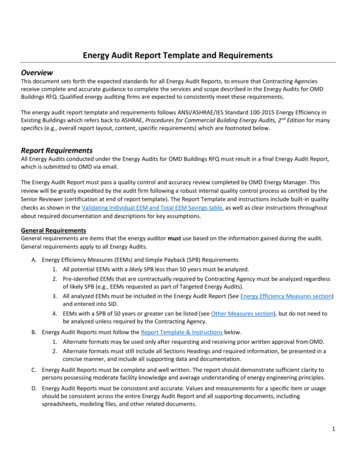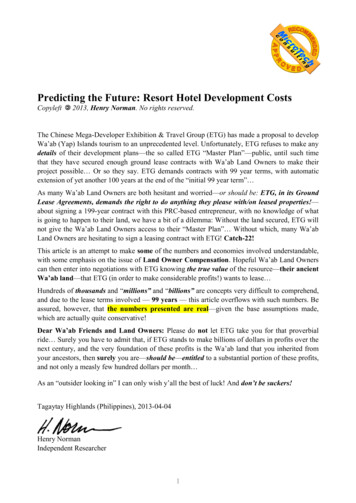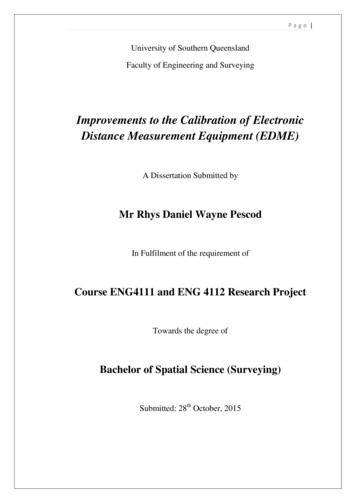
Transcription
Table of Contents teaser:Industrial wireless has specific requirements in terms of performance, reliability and security. Variouswireless technologies including the ISA 100.11a protocol are employed to meet these requirements inareas such as topology, security and customization.Fast Forward Bullet Points: Various wireless topologies can be employed to meet the demands of industrial wirelessapplications including star, tree, mesh and cluster.Industrial wireless protocols typically provide security features such as encryption,authentication and key management to ensure protected communications.Reliability is assured through redundancy, intelligent channel hopping, time synchronization andother features.Resource Box:1. Analysis of Wireless Industrial Automation Standards: ISA-100.11a and ?Section Article Index1&template /ContentManagement/ContentDisplay.cfm&ContentID 932572. A Real Mesh;http://www.isa.org/InTechTemplate.cfm?Section Article Index1&template /ContentManagement/ContentDisplay.cfm&ContentID 799473. Opportunities for Smart Wireless Ph, Conductivity ?Section Article Index1&template /ContentManagement/ContentDisplay.cfm&ContentID 80886Field Wireless NetworksISA100.11a and other wireless technologies are making inroads into processcontrol and measurement applicationsBy Amit Ajmeri, Consultant for Wireless and Field Network Technology at Yokogawa Corporation ofAmerica.Mr. Ajmeri has been with Yokogawa for over ten years. Prior to joining Yokogawa, he spent 12 years withEmerson Process Management promoting Foundation Fieldbus technology and interoperability. Hecurrently represents Yokogawa on various committees for ISA, FDT Organization, HART and FoundationFieldbus. His email address is amit.ajmeri@us.yokogawa.com.Industrial wireless devices and networks are used for measurement and control applications in areas inprocess plants where it’s too difficult or too expensive to hardwire sensors, transmitters and finalcontrol elements. They are also used for temporary applications, such as in research and developmentand pilot plants.Page 1 of 10
While most consumer wireless networks are used for convenience, industrial field wireless networksmust be much more reliable, and cannot interfere with other wireless applications in the plant. Thesenetworks, and their accompanying wireless devices, must also be simple to support with existing plantpersonnel.Finally, industrial wireless networks and devices must easily integrate with existing wired devices andnetworks, and the entire wireless system must be very flexible and scalable.Wireless Solutions for the Process IndustryThere are three basic areas in which industrial field wireless networks can operate in the processindustry: the global canopy, a site backbone and a field mesh. The global canopy is the term used forlong range wireless communication. It can be made up of a site-to-site private network joining locationsup to hundreds of miles apart, or it can use public networks such as the Internet, satellite or cellularcommunications. This type of network is used for data transmission over very long distances.A site backbone is a good solution in cases where data is transmitted from cell-to-cell within atransmission distance of a few miles. Although the distances covered are shorter than with a globalcanopy, a site backbone network can still be used to transmit data over relatively long distances.A field mesh or wireless sensor network is used for sending and receiving a few kilobytes (kB) of dataover a short range up to a few hundred feet. These field wireless networks are comprised of sensorsand actuators, field mobile devices and field end points—and these types of networks will be the focalpoint of this article.Frequency BandsCommunication frequency is one of the most important factors when implementing a field wirelessnetwork. The 2.4 gigahertz (GHz) wireless communication frequency band is most commonly used forindustrial applications. It’s part of the industrial, scientific and medical (ISM) radio bands that wereoriginally reserved for international use of RF energy for ISM purposes, as opposed totelecommunications.The ISM band has become the de facto standard because it is available worldwide and does not requirelicensing. Within that band, 2.4 GHz communications are used in the following standards:- IEEE802.11b/g/n (Wi-Fi) is used for a wireless local area network with communication distances of 300to 900 feet with a data communication rate of a few megabytes per second.- IEEE802.15.1 is used for Bluetooth communications that require extremely low power over a very shortcommunication range of 3 to 30 feet.- IEEE802.15.4 is a self-organizing, self-healing mesh network used in low power personal area networks.ZigBee, ISA100.11.a and WirelessHART use variations of this standard.Page 2 of 10
- IEEE802.16e is used for the WiMax communication protocol and covers a 3- to 30-mile range with adata transmission rate of approximately 72 megabytes (MB) per second.Wireless for Industrial AutomationFigure 1 depicts various types of networks within a plant. Wireless sensors (XC, XX, XV, etc.) are locatedat the bottom of the diagram. The architecture may include a wireless sensor network working at aremote location exchanging data with the process control network using 802.11 Wi-Fi or 802.16 WiMaxtechnologies.Located at the next level up, between the DCS and PLC automation systems and the wireless sensors,are access points or gateways. Gateways are the interface point between the wireless network and thehost automation system. The gateway talks to the sensors wirelessly, and communicates with theautomation system using wired protocols such as serial Modbus, Modbus TCP or Ethernet IEEE 802.3.With most wired protocols, distance is a limiting factor, so the gateways are typically located close tothe automation system.In most industrial applications, there are other devices using wireless communications such as cameras,RFID systems and cell phones—so methods must be devised to reduce interference and ensure reliablecommunications.Network TopologiesThere are a variety of wireless network topologies that can be used depending on applicationrequirements including star, tree, mesh and cluster. The ISA 100.11a protocol supports all of thesetopologies (Figure 2).The star topology is typically used with reduced function devices that are only powered by batteries. Fullfunction devices that work with batteries or line power are more adaptable for use with othertopologies.The most basic network type is the star topology with one functioning routing or center node that sendsand receives information from all of the end nodes. Thus, the end nodes only have one function:transmitting data to the center node. As a result, the end nodes consume very little power because theyonly send information to the center node, then go back into sleep mode.In addition to reducing the energy needs at end nodes, the star topology prevents any end node failurefrom affecting the rest of the network because every end node device is isolated from the largernetwork by the link that connects it to the center node.The mesh topology is comprised of nodes that can each route data from neighboring nodes as long asthey are in the same radio frequency range. The mesh network system provides reliable, secure datatransmissions and is highly scalable. If a path via one node or set of nodes isn’t working, a node canPage 3 of 10
route its data to a neighboring node, with the information eventually reaching the destination node viathis alternate path.The tree and cluster topologies are a combination of the star and mesh networks. The tree network hasone communication node with star nodes below it, and the cluster network is a combination of star andmesh networks.SecuritySecurity is a critical factor for industrial wireless systems used in the process industries, so mechanismsfor protecting the wireless network must be implemented. The ISA100.11a standard has several securitymeasures that can be applied to keep the network safe including:- Encryption: Each ISA100.11a data communicator has 128-bit encryption.- Authentication: Only devices authenticated by the system manager and security manager canexchange data.- Integrity: Each data point uses an end-to-end MAC address to ensure data integrity and transportsecurity.- Key Management: All wireless devices must have a join key that acts as a password that the deviceuses to authenticate it to the network. This is a key differentiator for the ISA100.11a protocol.Authenticate key management and join process technology enhance the security of the network bypreventing an unauthorized node from joining the network. All node authentications are controlled bythe network Security Manager which requires any device joining the network to provide all itscredentials in an encrypted fashion (join key) to the gateway. Each data packet has a 128-bit encryption.End-to-end basis transport security includes message-level security such as message encryption, as wellas transport-level security such as Windows.All wireless devices are given a join key by the network administrator who sets the parameters requiredto access the network. Once the join key is recognized and the device has joined the network, theSecurity Manager issues it additional keys (master key, session key, private key) for furthercommunication. These keys should be periodically updated as limiting their life spans further protectsthe network.The “hop by hop” Media Access Control (MAC) address security requires every data element transmittedbetween two wireless nodes to provide the MAC address of the originating node as well as the end nodefor extra security.Coexistence StrategyPage 4 of 10
Since many wireless standards use the 2.4 GHz frequency band, it’s very important that the variouswireless technologies (Wi-Fi, WirelessHART, ZigBee, UWB and others) can operate together on the band.Among the best methods for establishing coexistence among the various wireless communicationdevices are spectrum spreading, frequency hopping, and time slotted and scheduled transmissions.Electronic and electrical noise within an industrial plant can cause disturbances if protective measuresaren’t taken. Lower power radio technology with a spectrum spread technique deployed at a 200 kBrate helps overcome the noise problem, as data is distributed among various channels then collectedand reassembled by the receiver. Frequency hopping, in which the data rapidly switches among manyfrequency channels, helps avoid congestion. These techniques are also a good way to increase securitybecause both the spectrum spread code and frequency hopping patterns are necessary to retrieve thedata sent over the network.Synchronized timing enables multiple access capabilities by assigning each device a particular time slotto avoid collisions. Deterministic transmitting (TDMA) can also provide effective power savings becauseonly the sending and receiving devices must be awake during the data transmission. TDMA offerssynchronized time sense in which each subnet gets time-synched data from the network protocolserver, ensuring that the entire wireless network data transmissions occur at the proper times.Other methods for overcoming obstacles are multi-path mesh networks and intelligent channel hopping.Wireless mesh networks route traffic towards the Internet gateway (IGW), or from the IGW to theaccess points. When multiple devices attempt to select the best throughput path towards a gateway,the traffic on these paths can diminish the speed and performance of the network. A multi-path meshnetwork seeks alternative paths during times of congestion to overcome this potential performanceproblem.ISA100.11a also supports the black listing of channels. For example, a plant uses Wi-Fi channel 3 forISA100.11a communications, and channels 21 and 24 for general Wi-Fi communications. The SystemManager can be configured so the channels 21 and 24 are blacklisted for ISA100.11a communications toavoid performance issues on the network. In this scenario, there are two separate channels: onechannel for the Wi-Fi and another for ISA100.11a communications, enabling the two wirelesstechnologies to coexist in the plant.ReliabilityReliability is of paramount importance for industrial process control and measurement applications, andthe ISA100.11a standard has numerous techniques for ensuring reliable communications such asredundancy, intelligent channel hopping, Duo Cast technology and time synchronization.A mesh network offers redundancy because it can reroute data from one node to the destination mode,avoiding the obstructed node. For additional reliability, redundancy can also be implemented at thegateway, backbone, security system and system manager. For example, if one backbone router fails, theother router retrieves the data from the sensors, and then sends the information to the gateway.Page 5 of 10
Another method to ensure accurate throughput is channel hopping in which clear channel accesstechnology dynamically chooses different channels of operation to avoid interference. In addition,frequent retry attempts are made to limit data latency to 100 milliseconds or less (Figure 3).ISA100.11a also supports Duo Cast for redundant connectivity in which one device sends information totwo neighboring nodes simultaneously. The two receiving nodes send a confirmation from both enddevices in the same time slot. Without Duo Cast, if one communication path fails, a retry attempt is usedbefore going to a neighboring channel to transmit the data, which can slow communications.Time synchronization is highly accurate because each data packet is time stamped using InternationalAtomic Time. All data has a time slot allocation, and the data must reach its end destination and receivea confirmation from each node within that time slot. There is a very limited time to capture the datapacket and decipher the information, which provides very secure communication.Scalability and FlexibilityEach ISA100.11a end device uses Internet Protocol version 6 (IPv6), the newest Internet technology. Thishelps future proof the network by enabling access from a field wireless node using the latest IPtechnologies.The ISA100.11a protocol has many features to provide scalability in terms of the number of nodes thatcan be added, as well as how much area can be covered. To expand the network and add more nodes,an additional backbone router can be added to create a subnet. Multiple subnets, slow hopping mode,protocol mapping, and tunneling and backbone routing are all examples of the multi-functionality of theISA100.11a architecture.For fast firmware downloads and increased staff mobility, ISA100.11a supports the slow hopping modeusing Carrier Sense Multiple Access. This enables a channel to be locked for a specific period of time,instead of hopping every 10 milliseconds. The slow hopping mode is particularly beneficial whenperforming a firmware download to upgrade a radio or sensor electronics for a wireless node. It alsofacilitates the use of a handheld device for calibration checks, and for configuring a specific device.Protocol mapping and tunneling reduces infrastructure costs by supporting legacy protocols andcombined wire and wireless integrations. The ISA 100.11a architecture supports many existing protocolsincluding but not limited to Foundation Fieldbus, HART, Profibus, Modbus and CIP.The ISA100.11a stack includes provisions for protocol mapping and tunneling to enable FoundationFieldbus, HART and Profibus to use the SP100.11a stack for wireless communications. ISA100.11a istargeted for measurement and control applications that can function with one-second data rate, and italso supports peer-to-peer communications for PID loop scheduling (Figure 4).Page 6 of 10
As pictured in Diagram 4, a HART device can transmit data by putting an ISA100.11a wrapper on top ofthe HART data, and then sending the data through the wireless network router. When the data isreceived at the gateway the ISA wrapper is removed, and the HART data is then provided to thenetwork.Customizable Network PerformanceTo provide support for control applications, a subnet can be created with a one-second data update ratevia direct communications to the backbone router. This enables a one-second transmission speed fromthe node to the automation system.Multiple subnets can work in the same physical space and share a single wireless network with flexiblecustomization for optimal network performance. In addition to sharing a single network, ISA100.11a alsoallows networks with different communication speeds to operate in the same physical space. Forexample, one subnet can be comprised of low-speed sensors, while another provides a one-secondupdate rate for control applications.ISA100.11a supports peer-to-peer control communications, so the data from a measuring device doesnot need to go to the gateway, but can instead be transmitted directly to the final end control element.These peer-to-peer communications enable data exchange from one wireless node to another wirelessnode within a high-speed subnet for one-second updates.ConclusionInteroperability testing and certification from the ISA100 Wireless Compliance Institute ensures allmanufacturers’ wireless devices can communicate with the backbone router and gateway withoutproblems in a plug-and-play manner.An ISA100.11a wireless network can be deployed and reconfigured through device installation andsoftware configuration and changes—instead of requiring burdensome wiring, addition of I/O modules,programming, and possible upgrades to the automation system. Moreover, many of the ISA100.11asystem components, such as the backbone routers and the System Manager, are designed as functionmodules that can be added or removed depending on system requirements.ISA100.11a provides reliability, scalability, high performance, and the ability to simultaneously supportnumerous devices and protocols. Yokogawa has been an innovator in developing field instrumentation,automation systems and software to support the latest wireless technologies, from temperature andpressure sensors to gateways and more. To learn more about Yokogawa’s wireless products, please -businesses-en.htmPage 7 of 10
Table 1: ISA100.11a Wireless Network Architecture ComponentsRoleInput/OutputRouterBackbone RouterSystem ManagerSecurity ManagerGatewayProvisioningSystem Time SourcePage 8 of 10Role Definition andResponsibilitiesSources or consumes data. Does notroute.Routes messages for other devicesoperating in the wireless subnet.Routes data via the backbone.Mitigates among devices operating inthe wireless subnet and devicesoperating on the backbone.The “brains” of the network. Managesall network devices through policycontrolled configurations based ondesired performance parameters.Enables, controls and supervises thesecure operation of all devices presentin the network.Provides an application interfacebetween the wireless network and theplant network.Provisions devices with configurationsrequired for operation within thenetwork.Responsible for maintaining the mastertime source of the network.
SIDEBAR: Understanding the ISA100 Family of StandardsThe International Society of Automation (ISA) was founded in 1945 as a global, non-profit organizationto set automation standards. The ISA100 standard was developed with funding from the U.S.Department of Energy for the purpose of creating a reliable and universal family of wireless standardsfor industrial automation applications. It’s a market-driven (not vendor-driven) standard created by acommittee primarily compromised of end users who vote on decisions regarding the standards and onrequirements for wireless plant-wide communications.The ISA100 is a family of standards, including: Working Group 15 which makes decisions for the Wireless Backhaul Network. This comprisesmiddle range cell communication within the plant environment. Working Group 14 for Trustworthy Wireless whose goal is to improve the reliability and securityof wireless, as well as simplifying configuration and usage in a plant environment. Working Group 18 for Power Harvesting that works to improve battery standardization. Working Group 21 for ISA100.21 Asset Tracking using RFID and Real-Time Locating Systemtechnologies. ISA 100.12 WirelessHART and ISA100.11a Converged Network Applications to create a singleglobal standard instead of two competing standards Working Group 16 for Factory Automation, which has a totally separate requirement for datalatency as compared to the process industry (Figure 5)The Process Applications (ISA100.11a) specification for wireless sensing networks is already completedand released. The Wireless Backhaul Network (ISA100.15) standard has preliminary specifications readyfor a vote.Other standards are less developed. Trustworthy Wireless (ISA100.14) is still in progress, as well as theWirelessHART and ISA100.11a for Converged Network Applications (ISA100.12) standard. Preliminaryspecifications are in place for the People and Asset Tracking Standard (ISA100.21).Page 9 of 10
Figure 1: Various wired and wireless network types are often found in a typical manufacturing facility.Figure 2: Network topologies for wireless networks can be a single star or tree topology or combinationsof topologies, such as a mesh or cluster.Figure 3: Channel hopping allows wireless devices to dynamically choose different channels of operationto avoid interference.Figure 4: The ISA100.11a standard can support multiple protocols simultaneously on a single network.Figure 5: This diagram depicts the ISA100 timeline for the several groups developing specifications forthe family of standards.Page 10 of 10
wireless technologies (Wi-Fi, WirelessHART, ZigBee, UWB and others) can operate together on the band. Among the best methods for establishing coexistence among the various wireless communication devices are spectrum spreading, frequen










